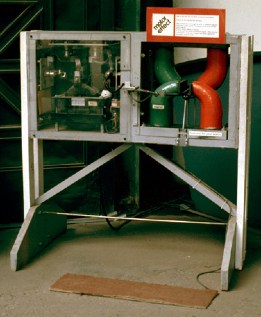| lines of relative motion, learning about relative phases and amplitudes by trial and error. There are some visitors who know all about what the pendulums are "supposed" to show. They use the exhibit to instruct their friends and children - and I also use it that way. This is a very good exhibit. I enjoy playing with it myself, and I enjoy showing it to you - no matter who you are; it is an exhibit for everybody. Many decisions went into its construction. It is versatile; visitors can find systematic things to do with it with relative ease; and one can obviously invent activities that are "out of context," clearly not part of any preconceived syllabus. The exhibit has other virtues as well. It is made entirely of hardware store parts: pipe, perforated angle iron, cable and turnbuckles, springs, etc. The hinging involves a short section of pipe rolling on two rods for the proper motion of the pendulum and a rocking motion from one rod to the other for the playful motions. The main defect in the exhibit is that, although there is elegance in the design, there is virtually none in the craftsmanship. Perhaps it was built in too much of a hurry. In contrast to the relative motion pendulum, our exhibit demonstrating the magnetic force on a wire carrying a current is a very poor one. We placed three exceptionally large permanent magnets to have a common poleface, making a horizontal rectangular magnetic field, 10 inches deep and 2 inches high, with a gap of about 2 inches. A thick wire carries about 250 amperes, triggered when a visitor steps on a mat switch. The wire is hinged so that a straight length of wire can move up and down through the magnetic field. When the current is turned on, the wire pops up through the field, and the visitor who tries to push the wire down feels the large, springlike force of opposed magnetic fields. One can even "feel" the current because of the imperfectly smoothed direct current. A good deal of thought went into the design and execution of the exhibit, and it forms an important link in a series of exhibits on electromagnetism. But it shows only one thing. When I demonstrated the piece to one of our staff members, she said, "The lid of my |  | ||||
The Motor Effect exhibit | |||||
| garbage can pops up when I step on the foot lever, too." This exhibit is a traditional science museum demonstration. It may even be a little better than most, because the magnet and the wire are out in the open and not behind glass. I frequently use the exhibit as a prop for teaching electromagnetic phenomena, but I never play with it as I walk by or show it to friends who visit the Exploratorium. It is not for me - it is not for you, it is for nobody. No side effects branch from the main phenomenon that it demonstrates. It just does what it is supposed to do; there is no way to make it misbehave. It does not even contain any redeeming features of beauty or whimsy. Too much was designed out of the exhibit. In order to let people feel how strong the force is, the magnet was made strong; it would, therefore, have been dangerous to leave any loose pieces of iron around. The wire is large and stiff in order to carry the 250 amperes without growing hot. It is a single twisted bundle of wires and not a loose collection of flexible ones | |||||